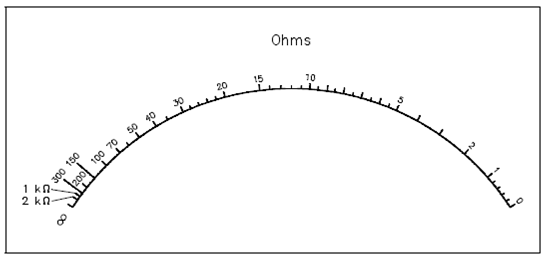Find out current:
An ohm meter with Ro = 30?, and full scale current Im = 300 µA. Find out I along with: 1) 0?, 2) 5?, 3) 10?, 4) 15?, and 5) 1 M? resistors across the meter terminal.
Solution:
First, deflection factor for every resistor must be found.
D = Ro/Ro + Rx
1. Rx = 0?
D = 30 /30 = 1
2. Rx = 5?
D = 30/30 + 5 =0.86
3. Rx = 10?
D = 30/30 + 10 =0.75
4. Rx = 15?
D= 30/30+15 =0.67
5. Rx = 1 M?
D= 30/1 x 106 =1 x 10-6 = 0.000001 approximately 0
Then find out I through using:
I = D Im
1. Rx = 0?
I = (1) (300 x 10-6) = 300 µA full scale deflection
2. Rx = 5?
I= (0.86) (300 x 10-6) = 258 µA
3. Rx = 10?
I = (0.75) (300 x 10-6) = 225 µA
4. Rx = 15?
I = ( 0.67 ) ( 300 x 10-6) = 201 µA
5. Rx = 1 M?
I = (0) (300 x 10-6) 0 µA zero deflection
NOTE: As the resistance was increased from 0 to 5? , meter current decreased through 42 µA. As same, while resistance was increased from 5 to 10? , the current decreased by 33 µA. Therefore, an ammeter scale used to measure resistance is nonlinear that was show in the figure. The ohm meter scale is a reversal of the ammeter and voltmeter scales. Alternatively, the zero resistance (Rx = 0) is at the right end of the scale and infinite resistance (Rx = 1 M ) is at the left end of the scale.

Figure: Ohm Meter Scale